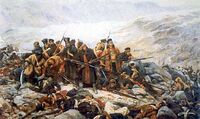Radical Nationalism is an art movement associated with the ideology of Radical Nationalism. Radical Nationalist artists are frequently supported by money from the Global Radical Nationalist Movement. Radical Nationalist art features a dramatization of peasant lives and especially folklore, often centering around a national epic or national genesis. Epic poems and operas with heroes of old are especially popular, while painters aspire to create the pseudo-fantastical elements of the subject matter.
In Music[]
In music, Radical Nationalist composers sought to unify and harmonize the tunes from their nations' folk music with the the avant garde and neo-Classical trends that were internationally popular. This is often done with an extended fermata leading to a change of tempo, as in the works of Jean Valjean or Pjeter Bruegel.

The heightened stress and shock musical effect of the Sturm und Drang movement is closely affiliated with Radical Nationalism. In addition, Radical Nationalist music centers around the opera and operatic music, combining composed music with spoken music. Radical Nationalist operas often center around an archetypal folk hero, usually a peasant, who rises to become a powerful soldier, and with the aid of the Father of the Nation is able to turn back the enemy -often barbarians or such. The Opera "Der Drumstang" by Viktor Pushenko is the most famous of this genre.
In Visual Art[]
Radical Nationalist paintings and sculptures seek to emulate the ancient, and combine it with elements of the modern. In that sense, Radical Nationalist paintings and sculptures are often surreal, focusing on a reality that conveys meaning not truth.

Paintings often depict dramatized and romanticized pastoral scenes, or scenes from the nation's mythology, such as Pedro Sacoza's The Rebellion of Jumantha.
The use of colors is often bright in Radical Nationalist poetries, and the contrast leads to a real but at the same time surreal depiction of events. Paintings such as the "Golden Sunset", the "Last Stand of Captain Sparrow", or "The Fall of Sir Egbert", often highlight a major feature of Radical Nationalist paintings -the dramatization of the end or the last of something, leading to the mentality that Radical Nationalism is a renewal of something suppressed.
In Literature[]
Radical Nationalist literature focuses on the revival of the ancient epics. The National epic of each country is supremely important, and these ancient texts are dissected, analyzed, translated, and republished.

Robert Thomas
Literature that seeks to tell modern truths with ancient legends often retells the epics in a modern light, such as a The Siege of Catelin by Robert Thomas.
In addition, the Nationalist Hero, the Common Man who sacrifices himself for the Common Good, is oft written about in Radical Nationalist literature. A counter movement that can be seen as anti-Radical Nationalist has also emerged in literature that seeks to display the disillusionment of the common man with Radical Nationalism. The best example of this is the anonymously written Death of a Common Man.
In Architecture[]
Radical Nationalist architecture, as exemplified by the architects Gianni Dalla and Jorgen Morgenstrauss, the features of the classical architecture of the country are highlighted and overemphasized. Radical Nationalist architecture seeks to unite the real and the surreal, combining fantastical elements with pragmatic elements.

Radical Nationalist Architecture in Pontesi
The end goal of Radical Nationalist architecture, according to expert-analyst Gore Rasa, is "to make the individual feel proud of an ancient and noble tradition, so immensely powerful that the individual cannot question it. The tradition, the National Folk Tradition, must be made to seem to derive from Divine Right itself, and to be so amazing and unassailable that there can be no questioning it -and, because the State is the Guardian of the Tradition, there can be no questioning the state. As such, Radical Nationalist architecture is overtly political, and a clear attempt to mesmerize and to coerce submission to the will of the Radical Nationalist State."
People Associated with the Radical Nationalist Movement[]
Jean Valjean
Pjeter Bruegel
Viktor Pushenko
Pedro Sacoza
Gianni Dalla
Jorgen Morganstrauss
Robert Thomas
